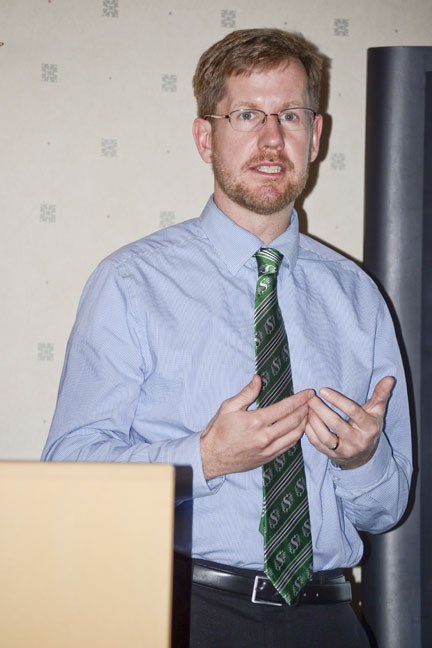A University of Regina researcher has taken an incident from his teens and used it to help create a safer workplace for Canadians.
Dr. Sean Tucker, who is an associate professor in the university's Faculty of Business Administration, was the speaker at the Estevan Chamber of Commerce's monthly luncheon last Wednesday.
Tucker said his primary field of interest is Occupational Health and Safety, something that came from an incident when he was working in construction at the age of 15. Tucker recalled that he was on scaffolding when the plank he was standing on gave way. Fortunately, there was an exposed beam that he could grab onto and avoid falling, saving him from a significant injury or worse.
"I found out later that the plank should never have been used, they weren't regulation," Tucker said. "It was apparent to me that this guy didn't care about my safety or anybody else's safety. That is one of the reasons I got into doing research and teaching occupational safety."
Tucker said although Saskatchewan has made strides, the province still has far too many workplace injuries, many of which are preventable. Currently, Saskatchewan is second in the country for accidents while Manitoba is first.
He noted that at one time, many businesses considered taking property safety measures an extra cost and didn't give the matter the attention it deserves. Tucker said that attitude has begun to shift because it has been proven that there is a solid financial case for businesses to properly manage the health and safety of their employees.
"Think about the cost benefit for investing in health and safety they can pay for themselves in a pretty short order."
The bulk of Tucker's speech focused on the concept of creating a safety climate in an organization. He noted that many companies talk about safety but don't necessarily back it up with their actions.
Tucker said in his research, they measure the safety culture in a given business through a questionnaire to employees. The 16 questions gauge the employee's opinions on the safety culture in a given workplace and have proven to be a good barometer, Tucker noted.
"We know that across dozens of studies that the stronger the safety culture, is the lower the injuries are going to be in those organizations," Tucker said.
"We know that supervisors matter, they are critical. When they act consistent with these behaviours, the culture is stronger and workplace injuries are lower."
Tucker said a number of trends came up during their research. One of note was that in companies where the owners included safety as part of the managers' performance review, the employees took note and rated management higher in terms of their commitment to safety.
"The first action in making an impact on safety would be including safety performance as part of the overall job performance," Tucker said. "It just sets the accountability in the organization at the top."
Tucker said his group is continuing to research workplace safety and any business that would like to take part in the safety climate audit can do so free of charge. Tucker's email address is: [email protected]




